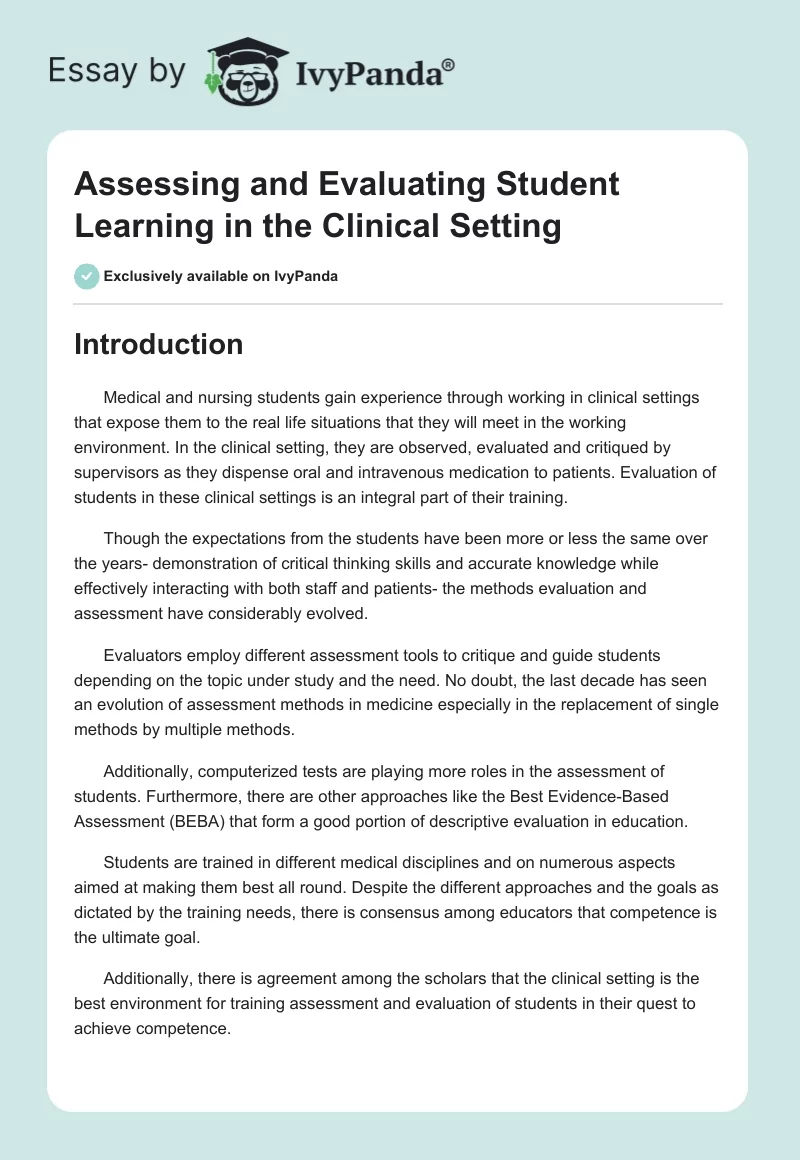Introduction
Medical and nursing students gain experience through working in clinical settings that expose them to the real life situations that they will meet in the working environment. In the clinical setting, they are observed, evaluated and critiqued by supervisors as they dispense oral and intravenous medication to patients. Evaluation of students in these clinical settings is an integral part of their training.
Though the expectations from the students have been more or less the same over the years- demonstration of critical thinking skills and accurate knowledge while effectively interacting with both staff and patients- the methods evaluation and assessment have considerably evolved.
Evaluators employ different assessment tools to critique and guide students depending on the topic under study and the need. No doubt, the last decade has seen an evolution of assessment methods in medicine especially in the replacement of single methods by multiple methods.
Additionally, computerized tests are playing more roles in the assessment of students. Furthermore, there are other approaches like the Best Evidence-Based Assessment (BEBA) that form a good portion of descriptive evaluation in education.
Students are trained in different medical disciplines and on numerous aspects aimed at making them best all round. Despite the different approaches and the goals as dictated by the training needs, there is consensus among educators that competence is the ultimate goal.
Additionally, there is agreement among the scholars that the clinical setting is the best environment for training assessment and evaluation of students in their quest to achieve competence.
Christie et al (2007, p. 1049) contents that authentic valuation i.e. in a clinical setting offers the best chance to gauge a student’s performance in real situations. Cassidy (2009, p. 34) agrees that students need to master competence in their area of practice through exposure to real life situations that they will be dealing with once they start practicing.
Subjectivity
In most of the literature like the above, use of the clinical setting is not in contention, rather the evaluation approaches used. Cassidy (2009, p. 34) says that provision of consistent and honest evaluation in clinical settings is crucial in the clinical setting evaluation. Cassidy adds that credibility of clinical assessments is needed to lend proficiency to the assessment strategies employed.
Christie et al (2007, p. 1049) concurs that even though clinical setting evaluation offers the best chance for authentic evaluation, the process needs to minimally flawless so that in order to gain credibility. Christie et al (2007, p. 1049) adds that clinical setting evaluation faces big challenges especially the making of subjective judgments about decisions made by students.
McMahon (2007, p. 1) also adds to the skewed perception about clinical setting evaluation and assessment methods. McMahon is more direct in his approach and asserts that the biggest challenge that is facing clinical setting evaluation today stems from the subjective view of student performance by faculty members (McMahon, 2007, p.1).
This, he adds raises their chances of failure in the most critical evaluation platform.. Unfortunately, many students during informal discussions reveal their perception of professional judgment as being subjective and personal.
Interestingly, the frustration bred by feelings of subjectivity is felt on both sides. Christie et al (2007, p. 1049) alludes to the fact that some works of research have uncovered the frustration that members of faculty feel from the perceived subjectivity that students face from them.
Christie continues to say that some of them have even expressed concern about reprisals including legal action by students. The importance of the clinical setting assessment and evaluation has led to scholars bringing forward suggestions that aimed at emphasizing its role in medical training and restoring the faith in it.
Justification
Both Cassidy (2009, p. 24) and Christie et al (2007, p. 1049), acknowledge that subjectivity or the feeling of it in clinical setting training and evaluation is unavoidable. Educators must therefore face their fears and acknowledge that assessment of professionalism especially in clinical situations must be subjective, personal and must be accompanied by an explanation (Christie et al, 2007, p. 1049).
Additionally, the practitioners who are also instructors must perform the evaluation during the time of stress and also undertake it during routine activities.
Cassidy on his part asserts that valid subjectivity is equivalent to propositional evidence that is drawn from the actions of students during clinical situations moments (2008, p. 34). In fact, subtle use of valid subjectivity provides credible means of assessment to instructors who try to use the captured clinical setting moments as shared learning experiences.
Conclusion/ Recommendation
Every student is entitled to positive feedback during assessment and evaluation including clinical settings. As McMahon suggests its important if immediate written and verbal feedback was given impetus to help guide the student in his/her quest to improvement (2007, p. 1).
Furthermore, there is need for the adoption of comprehensive faculty training programs that will help instructors develop more friendly approaches in delivering valid subjective judgments to students in clinical situations.
References
Cassidy, s. (2009). Subjectivity and the valid assessment of pre-registration student nurse clinical learning outcomes: Implications for mentors. Nurse Education Today (2009) 29, 33–39.
Christie, C. et al. (2007). Effectiveness of Faculty Training to Enhance Clinical Evaluation of Student Competence in Ethical Reasoning and Professionalism.
Journal of Dental Education Volume 71, Number 8 McMahon, J. (2007). What is Happening in Nursing: The Clinical Evaluation Process- Are your students “At Risk for Failure?”. Williamsport: Thomson Delmar Learning. Web.
Articles
Cassidy, s. (2009). Subjectivity and the valid assessment of pre-registration student nurse clinical learning outcomes: Implications for mentors. Nurse Education Today (2009) 29, 33–39. Web.
Christie, C. et al. (2007). Effectiveness of Faculty Training to Enhance Clinical Evaluation of Student Competence in Ethical Reasoning and Professionalism. Journal of Dental Education Volume 71, Number 8. Web.
McMahon, J. (2007). What is Happening in Nursing: The Clinical Evaluation Process- Are your students “At Risk for Failure?”. Williamsport: Thomson Delmar Learning. Web.


